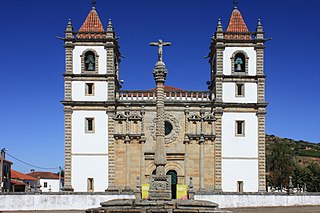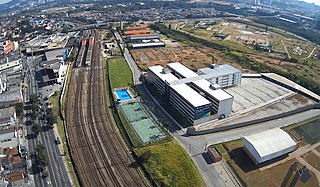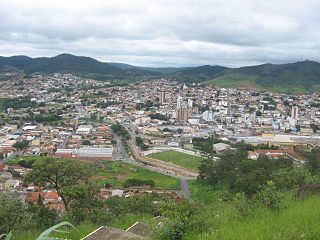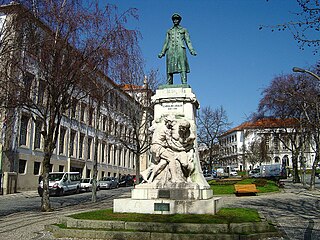See also
| This disambiguation page lists articles associated with the title Bragança. If an internal link led you here, you may wish to change the link to point directly to the intended article. |
Bragança may refer to:
| This disambiguation page lists articles associated with the title Bragança. If an internal link led you here, you may wish to change the link to point directly to the intended article. |

DomDuarte Pio, Duke of Braganza is a claimant to the defunct Portuguese throne, as the head of the House of Braganza. The Miguelist Braganzas, to whom Duarte Pio belongs as great-grandson of King Miguel I, is a cadet branch of the House of Braganza. With the extinction of male-line dynasts descended from Queen Maria II in 1932, King Miguel's descendants became the only male-line Braganzas remaining and the closest male-line heirs to the defunct Portuguese throne.

The federative units of Brazil are subnational entities with a certain degree of autonomy and endowed with their own government and constitution, which together form the Federative Republic of Brazil. There are 26 states and one federal district. The states are generally based on historical, conventional borders which have developed over time. The states are divided into municipalities, while the Federal District assumes the competences of both a state and a municipality.

Bragança, also known in English as Braganza, is a city and municipality in north-eastern Portugal, capital of the district of Bragança, in the Terras de Trás-os-Montes subregion of Portugal. The population in 2011 was 35,341, in an area of 1173.57 km².

Santo André is a Brazilian municipality located in the Metropolitan Region of São Paulo. It is part of a group of municipalities known as Greater ABC Region. The population is 710,210 in an area of 175.8 km².

Bauru is a Brazilian municipality in midwestern region of the state of São Paulo. It is the main city of the mesoregion and microregion of Bauru. The population is 366,992 in an area of 667.68 km². Established in 1896, its boundaries are Reginópolis to the north, Arealva to the northeast, Pederneiras to the east, Agudos and Piratininga to the south and Avaí to the west.

Carapicuíba is a municipality in the state of São Paulo in Brazil. It is part of the Metropolitan Region of São Paulo. The population is 392,294 in an area of 34.55 square kilometres (13.34 sq mi). It is one of the most densely populated municipalities in the state of São Paulo.

Cunha is a Galician and Portuguese surname of toponymic origin, documented since the 13th century.

Bragança Paulista is a municipality in the state of São Paulo in Brazil. The population is 160,665 in an area of 512.6 km². The elevation is 817 m.
Nogueira, Galician and Portuguese for walnut tree, may refer to:

Guarulhos is a Brazilian municipality. It is the second most populous city in the Brazilian state of São Paulo, the 13th most populous city in Brazil, and is also the most populous city in the country that is not a state capital. In the last few years it has outgrown Campinas. It is part of the Metropolitan Region of São Paulo. The population is 1,324,781 in an area of 318.68 km2. It is the most populous non-capital city in the country and has the second-largest GDP in the state, the 8th largest in the country.

São Caetano do Sul is a city in São Paulo state in Brazil. It is part of the Metropolitan Region of São Paulo. The population is 158,024 in an area of 15.33 km2. It is the city with the highest per capita income in Brazil and it also has the highest Human Development Index.

Pedro Henrique of Orléans-Braganza, was a great-grandson of the last emperor of Brazil, Pedro II, and one of two claimants to the abolished throne.

Pará de Minas is a Brazilian municipality located in the state of Minas Gerais.
Ribeirão may refer to:

Vila Real is the capital and largest city of the Vila Real District, northern Portugal. The population in 2011 was 51,850, in an area of 378.80 square kilometres (146.26 sq mi).

Luís Carlos de Oliveira Preto, known as Pintado, is a Brazilian retired footballer who played as a midfielder, and is the manager of Juventude.

The Pantheon of the House of Braganza, also known as the Pantheon of the Braganzas, is the final resting place for many of the members of the House of Braganza, located in the Monastery of São Vicente de Fora in the Alfama district of Lisbon, Portugal. The pantheon's burials have included Portuguese monarchs, Brazilian monarchs, a Romanian monarch, queen consorts of Portugal, and notable Infantes of Portugal, among others.

The Castle of Algoso is a medieval castle in the civil parish of Algoso, Campo de Víboras e Uva, municipality of Vimioso, in the Portuguese district of Bragança. The castle of Algoso is one of the most important medieval fortifications in the eastern Trás-os-montes, related with the battles of Leonese succession, the tentative policies of the independent Portuguese monarch and the important religious commandery of the Knights Hospitaller that established their roots in 1224.

The Ilha Anchieta State Park is a state park in the state of São Paulo, Brazil

Luiz Philippe of Orléans-Braganza is a Brazilian politician, activist, businessman, and member of the imperial House of Orléans-Braganza. He was elected Federal Deputy for São Paulo in the 2018 Brazilian elections for the Social Liberal Party with 118,457 votes.